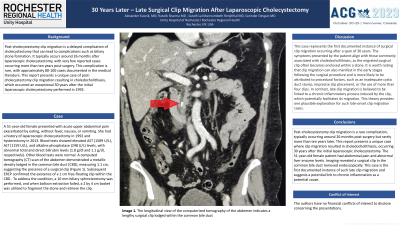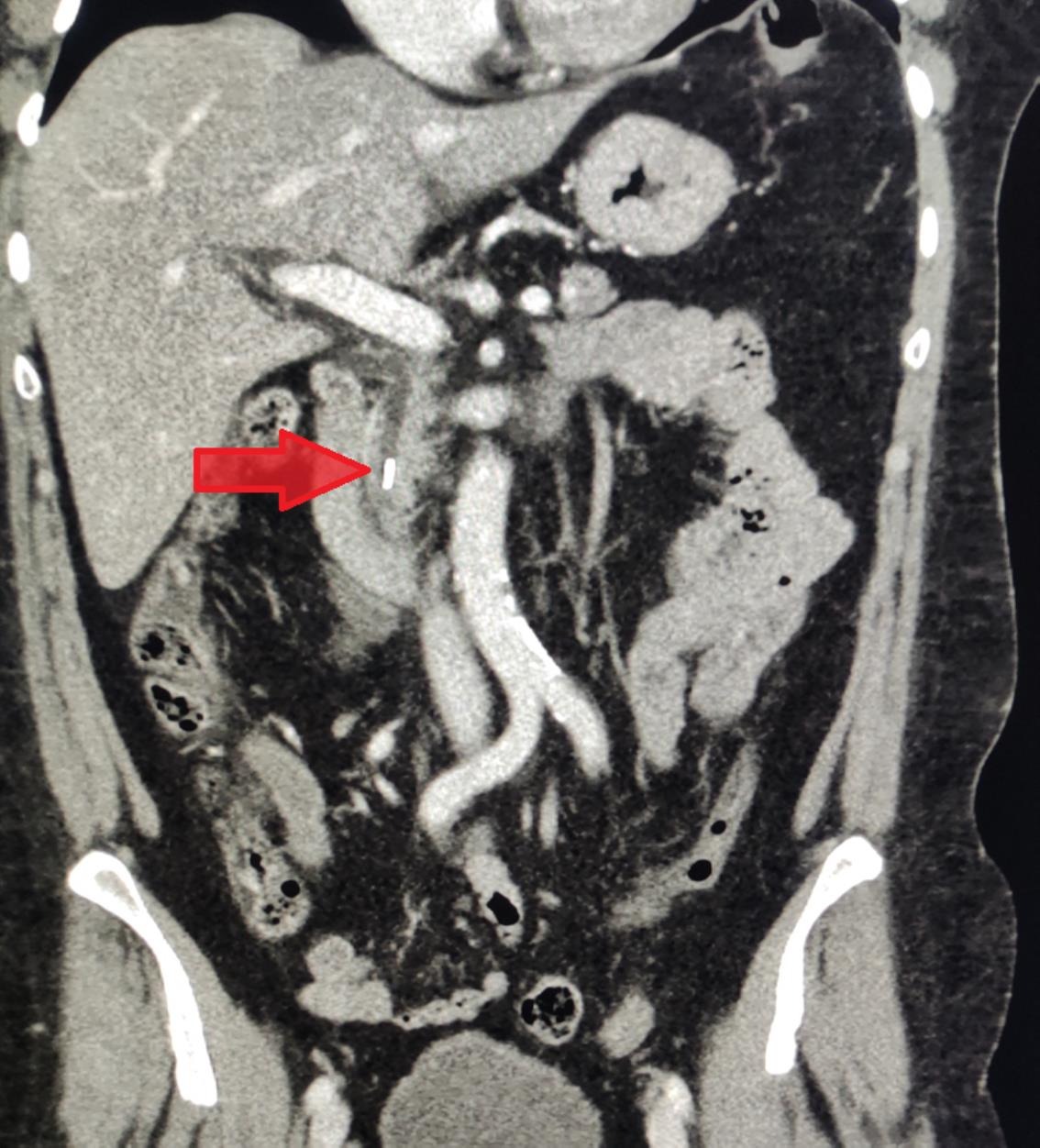Tuesday Poster Session
Category: Biliary/Pancreas
P2895 - 30 Years Later – Late Surgical Clip Migration After Laparoscopic Cholecystectomy
Tuesday, October 24, 2023
10:30 AM - 4:00 PM PT
Location: Exhibit Hall

Has Audio
.jpg)
Alexander Kusnik, MD
Unity Hospital
Rochester, NY
Presenting Author(s)
Alexander Kusnik, MD, Rutwik Sharma, MD, Sarath Lal Mannumbeth Renjithlal, MD, Surinder Devgun, MD
Unity Hospital, Rochester, NY
Introduction: Post-cholecystectomy clip migration is a delayed complication of cholecystectomy that can lead to complications such as biliary stone formation. It typically occurs around 26 months after laparoscopic cholecystectomy, with very few reported cases occurring more than ten years post-surgery. This complication is rare, with approximately 80-100 cases documented in the medical literature. In this report, we present a unique case of post-cholecystectomy clip migration resulting in choledocholithiasis, which occurred an exceptional 30 years after the initial laparoscopic cholecystectomy performed in 1992.
Case Description/Methods: A 51-year-old female presented with acute upper abdominal pain exacerbated by eating, without fever, nausea, or vomiting. She had a history of laparoscopic cholecystectomy in 1992 and hysterectomy in 2013. Blood tests showed elevated AST (1589 U/L), ALT (1159 U/L), and alkaline phosphatase (248 U/L) levels, with abnormal total and direct bilirubin levels (1.8 g/dl and 1.1 g/dl, respectively). Other blood tests were normal. A computed tomography (CT) scan of the abdomen demonstrated a metallic density lodged in the common bile duct (CBD), measuring 1.1 cm, suggesting the presence of a surgical clip (Figure 1). Subsequent ERCP confirmed the existence of a 1 cm free-floating clip within the CBD . To address the condition, a 10 mm biliary sphincterotomy was performed, and when balloon extraction failed, a 2 by 4 cm basket was utilized to fragment the stone and retrieve the clip.
Discussion: To the best of our knowledge, this case represents the first documented instance of surgical clip migration occurring after a span of 30 years. The symptoms presented by the patient align with those commonly associated with choledocholithiasis, as the migrated surgical clip often becomes enclosed within a stone. It is worth noting that clip migration can also manifest in the early stages following the surgical procedure and is more likely to be attributed to procedural factors, such as an inadequate cystic duct stump, imprecise clip placement, or the use of more than four endoclips. In contrast, late clip migration is believed to be linked to a chronic inflammatory process induced by the clip, which potentially facilitates its migration. This theory provides one plausible explanation for such late-onset clip migration cases.

Disclosures:
Alexander Kusnik, MD, Rutwik Sharma, MD, Sarath Lal Mannumbeth Renjithlal, MD, Surinder Devgun, MD. P2895 - 30 Years Later – Late Surgical Clip Migration After Laparoscopic Cholecystectomy, ACG 2023 Annual Scientific Meeting Abstracts. Vancouver, BC, Canada: American College of Gastroenterology.
Unity Hospital, Rochester, NY
Introduction: Post-cholecystectomy clip migration is a delayed complication of cholecystectomy that can lead to complications such as biliary stone formation. It typically occurs around 26 months after laparoscopic cholecystectomy, with very few reported cases occurring more than ten years post-surgery. This complication is rare, with approximately 80-100 cases documented in the medical literature. In this report, we present a unique case of post-cholecystectomy clip migration resulting in choledocholithiasis, which occurred an exceptional 30 years after the initial laparoscopic cholecystectomy performed in 1992.
Case Description/Methods: A 51-year-old female presented with acute upper abdominal pain exacerbated by eating, without fever, nausea, or vomiting. She had a history of laparoscopic cholecystectomy in 1992 and hysterectomy in 2013. Blood tests showed elevated AST (1589 U/L), ALT (1159 U/L), and alkaline phosphatase (248 U/L) levels, with abnormal total and direct bilirubin levels (1.8 g/dl and 1.1 g/dl, respectively). Other blood tests were normal. A computed tomography (CT) scan of the abdomen demonstrated a metallic density lodged in the common bile duct (CBD), measuring 1.1 cm, suggesting the presence of a surgical clip (Figure 1). Subsequent ERCP confirmed the existence of a 1 cm free-floating clip within the CBD . To address the condition, a 10 mm biliary sphincterotomy was performed, and when balloon extraction failed, a 2 by 4 cm basket was utilized to fragment the stone and retrieve the clip.
Discussion: To the best of our knowledge, this case represents the first documented instance of surgical clip migration occurring after a span of 30 years. The symptoms presented by the patient align with those commonly associated with choledocholithiasis, as the migrated surgical clip often becomes enclosed within a stone. It is worth noting that clip migration can also manifest in the early stages following the surgical procedure and is more likely to be attributed to procedural factors, such as an inadequate cystic duct stump, imprecise clip placement, or the use of more than four endoclips. In contrast, late clip migration is believed to be linked to a chronic inflammatory process induced by the clip, which potentially facilitates its migration. This theory provides one plausible explanation for such late-onset clip migration cases.

Figure: The longitudinal view of the computerized tomography of the abdomen indicates a lengthy surgical clip lodged within the common bile duct
Disclosures:
Alexander Kusnik indicated no relevant financial relationships.
Rutwik Sharma indicated no relevant financial relationships.
Sarath Lal Mannumbeth Renjithlal indicated no relevant financial relationships.
Surinder Devgun indicated no relevant financial relationships.
Alexander Kusnik, MD, Rutwik Sharma, MD, Sarath Lal Mannumbeth Renjithlal, MD, Surinder Devgun, MD. P2895 - 30 Years Later – Late Surgical Clip Migration After Laparoscopic Cholecystectomy, ACG 2023 Annual Scientific Meeting Abstracts. Vancouver, BC, Canada: American College of Gastroenterology.
